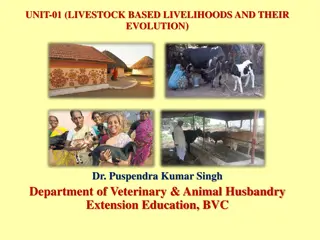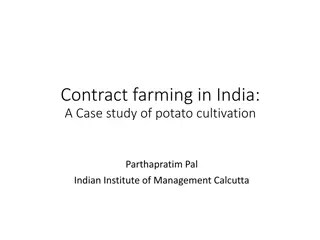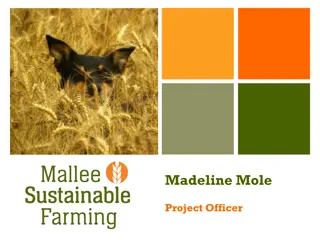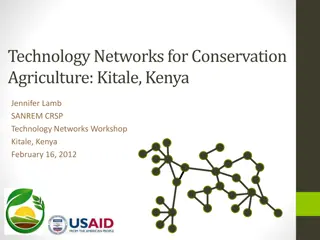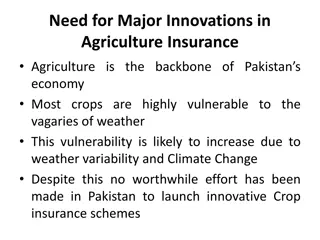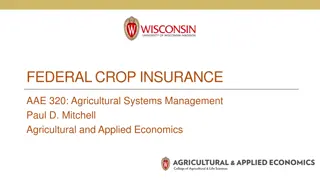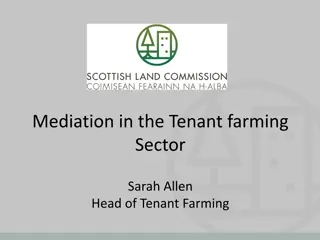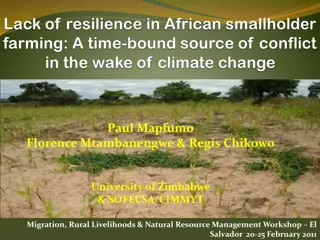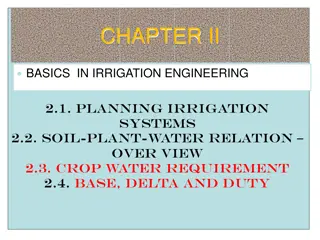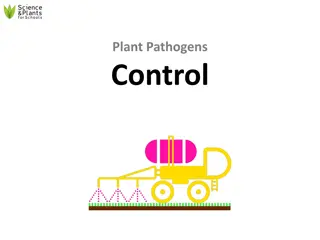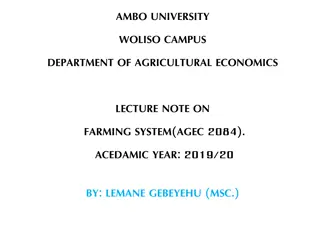Effective Target Crop Selection for Sustainable Farming Initiatives
"Learn how to efficiently implement target crop selection in farming projects with steps such as conducting sensitization workshops, surveys, and training sessions. Farmers are empowered to make informed decisions on crop selection based on market demands, leading to collective production and marketing. Extension staff play a crucial role in guiding farmers throughout the process."
Download Presentation

Please find below an Image/Link to download the presentation.
The content on the website is provided AS IS for your information and personal use only. It may not be sold, licensed, or shared on other websites without obtaining consent from the author. Download presentation by click this link. If you encounter any issues during the download, it is possible that the publisher has removed the file from their server.
E N D
Presentation Transcript
Target Target Crop Methods of Implementation Methods of Implementation Crop Selection Selection Type the name of your organization here. 1
WHERE ARE WE?: WHERE ARE WE?: Target Crop Selection Target Crop Selection in SHEP s 4 Steps Steps 4 Steps in SHEP s 4 Activities 1. Share goal with farmers. Sensitization Workshop Participatory Baseline Survey (optional) Stakeholder Forum Market Survey Target Crop Selection 2. Farmers awareness is raised. 3 . Farmers make decisions. Target Crop Selection is where the farmers make decisions. Crop Calendar Making 4. Farmers acquire skills. In-field trainings Follow-up and monitoring (including Participatory Endline Survey) 2
PART 1: CONCEPT PART 1: CONCEPT 3
WHY?: WHY?: Objectives of Target Crop Selection Objectives of Target Crop Selection The farmer groups collectively identify the specific types of crops that are demanded by the market. The farmers agree to produce and market the identified crops as a group. Note: During the In-field training in Step 4 , the farmers will learn how to produce the crops they have chosen during this activity. 4
WHAT?: WHAT?: Outline of Target Crop Selection Outline of Target Crop Selection The farmer groups select the target horticultural crops based on their finding during the market survey (and Stakeholder Forum, if implemented). The groups discuss their preferred crops and build a consensus on the crops they will grow as a group. The extension staff gives advice to the group during the crop selection process. 5
FORMAT: FORMAT: Target Crop Selection Sheet Target Crop Selection Sheet Information is filled out by the farmers. The farmers decide the ranking of each crop. 6
HOW?: HOW?: Key Key I Implementation Tips mplementation Tips The farmer groups discuss their future farming opportunities. They make decisions about the target crops based on their previous SHEP activities, in particular, the market survey. Raising Motivation 7
HOW?: HOW?: Key Key I Implementation Tips mplementation Tips The extension staff gives useful advice and suggestions, particularly in the area of agro-ecological suitability of specific crops. As a result, the farmers can make a well-rounded decision in choosing the target crops. Raising Motivation 8
PART 2: PRACTICE PART 2: PRACTICE 9
STEP: STEP: Implementation Procedures Implementation Procedures 1. Organize a meeting at the community and invite the group members as well as their spouses. [Tip!] Inviting the members spouses facilitate effective decision-making. 2. Ask the farmer group to discuss the findings of the market survey and fill out the information on the Target Crop Selection Sheet. [Tip!]Refer to the completed Baseline Survey Questionnaire and Market Survey. 3. Discuss advantages and disadvantages of potential target crops. Are they easy to grow, suitable to the local growing condition, affordable? [Tip!] The extension staff should give advice on production suitability and technical issues. Do not choose crops solely based on their profitability. 10
STEP: STEP: Implementation Procedures Implementation Procedures 4. Each group member votes for his/her preferred crops (blind voting) Write the name of his/her 1st& 2ndpreferred crops on the voting paper. The majority, preferably more than 70%, of the group members should participate in this process to build a consensus among the group members. For the 2ndcrop, repeat the process above. Rank the crops in accordance of the number of votes and choose two or three target crops. [Tip!] Make sure powerful members of the group (eg. group leaders, elderly or well-educated members) do not influence the group s decision. 11
Target Crop Selection Sheet Target Crop Selection Sheet Basic information of the farmer group Advice from Extension Staff is critical Info. Collected during the Market Survey & Info. Based on the Baseline Survey Ranking: Result of voting 12
CHECKLIST: CHECKLIST: Points to be Confirmed after Target Points to be Confirmed after Target Crop Selection Crop Selection The target farmers understand the methods of target crop selection. Not only profitability but also agro-ecological conditions, as well as the farmers technical skills and financial capacity are taken into consideration in choosing target crops. The target groups agree to undertake target crop selection on a regular basis by themselves in the future. The male-female ratio of the participants is balanced. The quality of participation of male and female members in decision-making is ensured. (optional) The members spouses are involved. 13
Target Crop Selection in Action Target Crop Selection in Action 14
TROUBLESHOOTING TROUBLESHOOTING What if a tie vote happens? Ask the farmers to vote again. This time, they will vote only for the crops which got the same number of votes. Isn t there a risk of oversupply? Selecting a few target crops do not necessarily saturate the local market as long as the farmers know when and what quantity they should supply to the market. What happens to the crops that are not selected? The benefit of selecting target crops are: - The farmers can get intensive production trainings on those crops from the extension staff during In-field Training. - The farmer groups can plan collective marketing for those selected crops. The Farmers are free to grow any other crops as they wish. 15
Way Way Forward Forward: : Implementation Schedule, Implementation Schedule, Reporting, Reporting, add any other necessary info. here add any other necessary info. here 16









